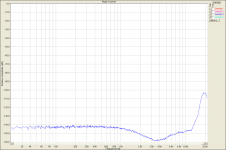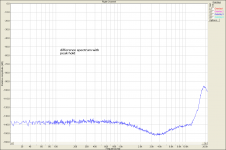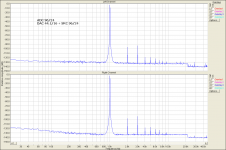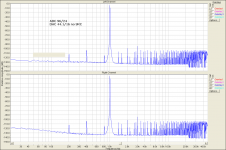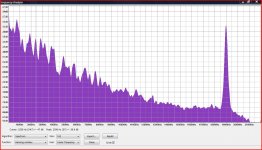Attachments
Last edited:
Very interesting ... what surprised me was the, for me, relative poor quality of the -3 and -4 files - the poor tone of the backing piano stood out ... and this is what made the difference quite clear - poor vs. poorer.
Surely the original wasn't so limited -- got the 192k FLAC, converted it to WAV, then played latter using Nero - ahhh, now this is more like it, we have a proper piano!
So, where does the 'fault' lie ...?
Surely the original wasn't so limited -- got the 192k FLAC, converted it to WAV, then played latter using Nero - ahhh, now this is more like it, we have a proper piano!
So, where does the 'fault' lie ...?
Just to go off at a tangent for a moment...
The audible difference in the last two files to me was very small indeed, the Bach perhaps a little more obvious, but the really really vital thing is what the whole experience conveys. The Bach was wonderful whether as MP3 or the original, it was full of life and vibrancy whereas the Linn recording for all its technical credentials comes across as acoustically dry and dead and lacking any emotion. That is the kind of thing I was hoping some of these tests might hint at with differing equipment and devices such as the opamps in that our circuitry can "enhance" the experience in some way even if its at the expense of getting that last 0.000xxx something. That you listen with an open mind and pick what sounds best to you.
I'm losing the plot with this particular post of mine 😀 so I'll leave it there. Hope it makes some sense.
---------------------------------------------------------------------------------
1) Can pick differences in sound
2) Know which one is important in the differences. Which one is acceptable which one is not.
3) Know the cause of the most objectionable differences
4) Quantify the maximum allowable existence of the cause in a design (for example if it is THD, is it 0.015%)
Plus, even on the true 192/24 version there is some type of recording overload, or misbehaviour: at 24 secs in, after the the note crescendo there is a momentary noise "zzzt" - or is this just a very weird musical instrument ...?
I'm not sure if I understand you but if you are resampling to 44.1/48kHz, you have to apply the correct 44.1/48kHz specific Noise Shaped dither to do this. You can't use the dither optimised for high sample rate.With high sample rate and bit depth TPF dither may be applied repeatedly; slowly but surely raising noise floor in white noise. On final rendering all may be redistributed, typically packing more noise into HF or ultra-sonic range. Brick wall is used once on way to 44.1/48kHz.
..smooth sinking of signal into noise .. is EXACTLY what you should have with proper dither. This holds with flat spectrum TPDF or Gaussian dither as well as properly implemented Noise Shaped dither.Working within 44.1/48kHz sample rate, redistributing noise power leads to test192_3 and test192_4 possibilities. Sure, noise floor in sensitive region is lowered; but at what cost? When music signal drops down to make use of this apparent space, fine spatial character is lost, and is accompanied by HF hiss. I'd rather have smooth sinking of signal into noise with more thermal type of roll off.
I don't think test192_3 and test192_4 illustrate the evils of Noise Shaped dither.
______________
Barley, Whose shaped dither have you used?
The Bach was wonderful whether as MP3 or the original, it was full of life and vibrancy whereas the Linn recording for all its technical credentials comes across as acoustically dry and dead and lacking any emotion.
That might have something to do with the quality of the performance rather than the quality of the recording. Also the room response was vastly different in the two cases. The Linn one sounding like it was in a recording studio rather than concert hall.
I assume when he spoke about Linn he meant the last 'tests192', he did not refer to cello Linn that you have linked few days ago.
All, it would be nice if we had more ABX screenshots. Now the test is as required many times before and we are taking into account ABX results only. What more can we do. And, at least to me, this test is very interesting.
All, it would be nice if we had more ABX screenshots. Now the test is as required many times before and we are taking into account ABX results only. What more can we do. And, at least to me, this test is very interesting.
4) Quantify the maximum allowable existence of the cause in a design (for example if it is THD, is it 0.015%)
I made several public tests with mathematically added non-linearity (harmonic distortion) in the past. You would be surprised how high amounts of harmonic distortion added, even patterns that contained many higher harmonics (decaying in amplitude with frequency) were inaudible. Harmonic distortion in isolation, that means just harmonic distortion and not some other influences, is very difficult to detect by listening. The mathematically added distortion fades out very quickly with amplitude, so it does not cover the phenomena like cross-over distortion. It is more likely similar to class A harmonic distortion.
Very interesting ... what surprised me was the, for me, relative poor quality of the -3 and -4 files - the poor tone of the backing piano stood out ... and this is what made the difference quite clear - poor vs. poorer.
Surely the original wasn't so limited -- got the 192k FLAC, converted it to WAV, then played latter using Nero - ahhh, now this is more like it, we have a proper piano!
So, where does the 'fault' lie ...?
Sample rate conversions, bit depth conversion, different dithering methods, ...... proper playback and possible sample rate conversions in sound chips .... more questions than answers. I find it very interesting.
All, it would be nice if we had more ABX screenshots. Now the test is as required many times before and we are taking into account ABX results only. What more can we do. And, at least to me, this test is very interesting.
What is the point of the ABX result? For kids, it is to show others how "good" we are. For adults like us, it is to differentiate whose opinion we will trust. For me who has been here for a decade, I don't need ABX test result as I have my own list. There are many GP on this DIYA who didn't appear on this thread. But even in this thread many of you have valuable comment.
So even Mooly doesn't pass the ABX for example, I will still value his comments. So are PMA, Frank, heb, Mohammed Li, kgrlee and so on.
The problem is actually not to find out if A is different than B, but (with known condition) which one is better. We can control the difference between the two. For example 16 bit versus 24 bit. Will 24 bit sound better?
Theoretically, it depends on amplifiers and speaker. What is the meaning of 24 bit if the amp has such a high noise floor and limited voltage swing, worse if the speaker is cheap. But my listening experience show that even with poor amps and speaker the difference is dramatic. But this is most probably from the quality of the D/A chip itself, not the resolution of the recording.
I have never enjoyed high resolution recording materials btw, so it is a good exercise. What I need from this thread is not the GP ears, but the materials you have posted (thanks for that) 😀
ABX says if the difference was heard or not, with probability that is quite high. Nothing less and nothing more.
There is a complex, strange dynamic between the 'quality' of a recording, and the competence of the chain being used for playing it back. This is where psychoacoustics climbs on board very strongly - IME it is very hard to say whether a particular recording will 'work' on a particular setup - no matter how primitive, or sophisticated, or measurably 'correct' they are. I have had too many experiences of supposedly highly superior systems make a mess of very familiar recordings to think anything else - great slabs of musical detail simply disappear, to be replaced by disturbing, edgy distortion, or, syrupy ambience unconnected with the recording.But my listening experience show that even with poor amps and speaker the difference is dramatic. But this is most probably from the quality of the D/A chip itself, not the resolution of the recording.
A 'poor' system may do an excellent job of highlighting differences, because its inadequacies neatly fall in line, synchronise with the 'failings', or differences between test tracks - rather than veil variations, they emphasise or magnify them ...
But again, without measurements and analysis one is lost. My card is clocked for 48kHz/96kHz. For 44.1kHz it uses inner sample rate converter (which performs horribly). Thus, i MUST use SW SRC for playback and I do use this in foobar. Please compare what I get from 44.1kHz with and without SRC. The 1kHz test signal is 16 bit, properly dithered.
Attachments
Again I'm reading all the replies. Hard to credit that the difference in the last set of test files is so minute.
heb1001 might find this interesting. Remember the 19.2kHz tone you were concerned over and that was proved to be being generated by the sound card on my old Acer. Well here is the output of an old FM tuner (Sony ST515, the companion to the TCK cassette deck). As a youngster I could detect that pilot tone on FM broadcasts 🙂
heb1001 might find this interesting. Remember the 19.2kHz tone you were concerned over and that was proved to be being generated by the sound card on my old Acer. Well here is the output of an old FM tuner (Sony ST515, the companion to the TCK cassette deck). As a youngster I could detect that pilot tone on FM broadcasts 🙂
Attachments
ABX says if the difference was heard or not, with probability that is quite high. Nothing less and nothing more.
For me, any one single person showing an ABX test result is sufficient to say that the difference is heard.
I always believe that even if "no-one" can hear any difference, the difference can be quite high. It seems to me that human ear is not as good as human brain.
Kgrlee mentioned that if a true GP cannot perceive any difference in 5 hours, then it cannot be perceived even in 5 days or something. But NO, I don't agree with that. What can be ABXed in a few minutes are not "important" information for me. If I had to do an ABX in days, I will, if it is any importance, but to who? Because I don't have a need to convince but myself (Imagine when you ABX a sound, when you are sure it is different, you will stop even with 4/4 trials. So what for are those 22/24? That's to convince others!).
I made several public tests with mathematically added non-linearity (harmonic distortion) in the past. You would be surprised how high amounts of harmonic distortion added, even patterns that contained many higher harmonics (decaying in amplitude with frequency) were inaudible. Harmonic distortion in isolation, that means just harmonic distortion and not some other influences, is very difficult to detect by listening. The mathematically added distortion fades out very quickly with amplitude, so it does not cover the phenomena like cross-over distortion. It is more likely similar to class A harmonic distortion.
Did your harmonic distortion simulation also calculate the IMD components that would be created by a real system that exhibits harmonic distortion?
I've done auralization with normalization of response recordings as per Dr. Geddes. What is readily apparent as changes in live sound are insignificant when listened to played back over headphones. Part of this is doubtless non linearity of human hearing. Another factor in live listening is two ears; how may distortion effect radiation pattern of speaker? Also how does radiation pattern of speaker when assumed to remain static over differing drive levels impact sound if radiation pattern is not truly static? For example in two way CD system with horn and direct radiator crossing over at 1kHz, the woofer is highly omnidirectional below 500Hz; distortion components generated by these fundamentals do not radiate with omnidirectional characteristic. Likewise all distortion components radiating from woofer mix with sound from horn in manner unintended by the speaker design. For stereo speakers with only partial signal correlation, the stereo imaging is changing in a distortion dependent manner. Speaker location becomes unmasked, and stereo image details become masked.
Lots of fodder here for "which do you prefer" studies.
Again I'm reading all the replies. Hard to credit that the difference in the last set of test files is so minute.
Mmm. Looks like you just ABXed noise at -100dB.
Doesn't surprise me.
Did your harmonic distortion simulation also calculate the IMD components that would be created by a real system that exhibits harmonic distortion?
Of course, IMD is only different expression of system non-linearity.
heb1001 might find this interesting. Remember the 19.2kHz tone you were concerned over and that was proved to be being generated by the sound card on my old Acer. Well here is the output of an old FM tuner (Sony ST515, the companion to the TCK cassette deck). As a youngster I could detect that pilot tone on FM broadcasts 🙂
Good!! 😀
(Mooly, try to enlarge "size") of your FFT (bottom left click box))
- Status
- Not open for further replies.
- Home
- General Interest
- Everything Else
- Based on sonics... which do you prefer ?
